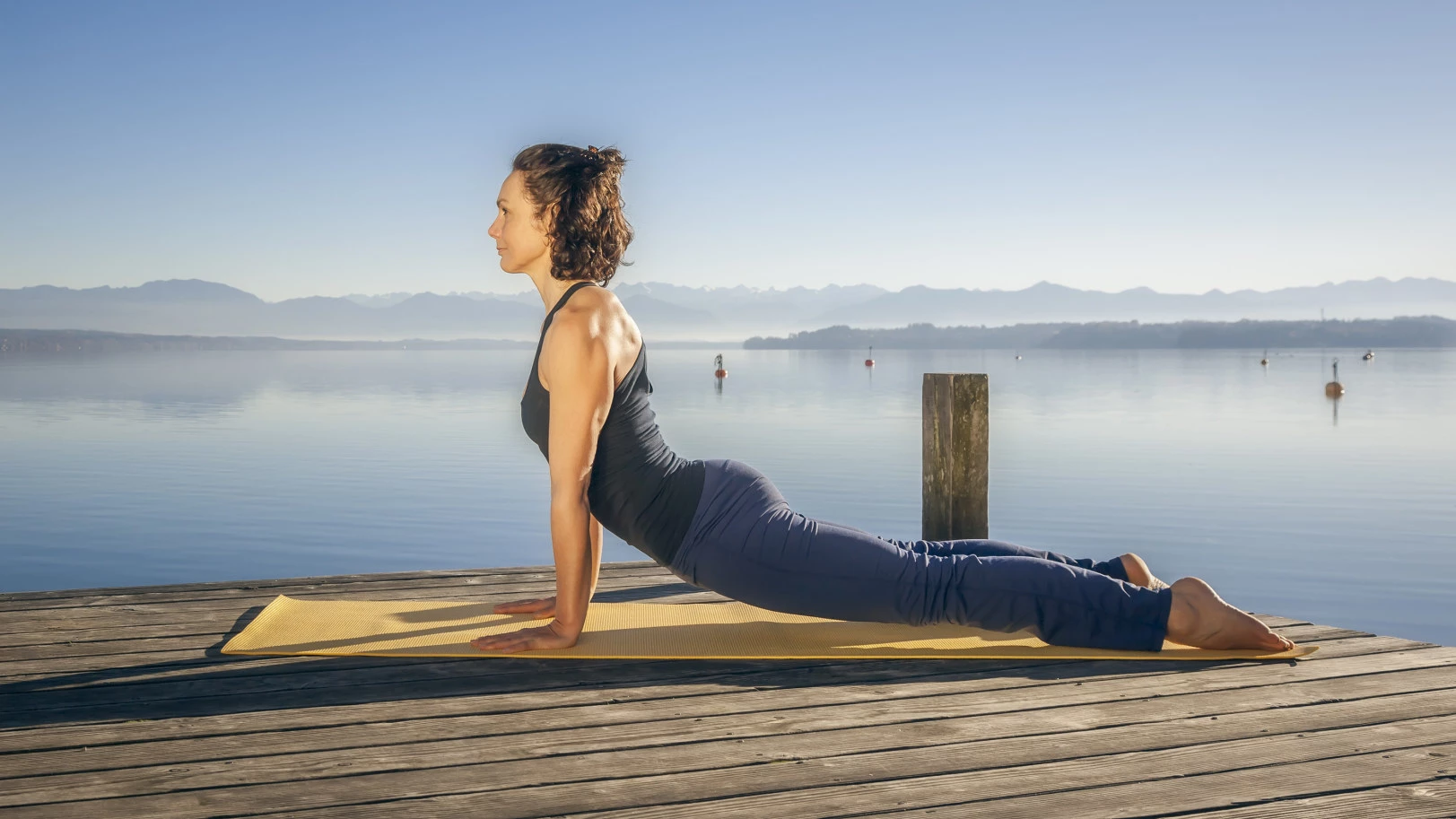Protecting the Elbow Complex During Yoga

Hand balances are a common part of many yoga classes. We often place weight on our hands as we progress through our poses.
We may move from a Bird Dog Pose (Parsva Balasana) variation, to Downward Facing Dog Pose (Adho Mukha Svanasana), to Upward Facing Dog Pose (Urdhva Mukha Svanasana) several times in one yoga class. Whatever dog you do (or teach), the joints of the hand, elbow and shoulder may be at risk.
Joint Injuries from Yoga
As more people practice yoga, more people are getting injuries from yoga. The causes of joint injury may include: stiffness, hypermobility, muscle weakness, or performing hand balances improperly.
We should not underestimate the importance our elbow joint complex has in the safety of our yoga practice. Our elbow is situated between two mobile joints and is susceptible to strain.
Anatomy of the Elbow Joint
Like the knee, the elbow is considered a complex hinge joint. Like the hinge to a door, this type of joint allows primarily one plane of motion. In the elbow, there are 4 joints (3 bones) that enable not only bending and straightening (flexion and extension), but also rotating the hand up (supination) and down (pronation). These joints are respectively: the humeroulnar joint, the c, the proximal radioulnar joint and the distal radioulnar joint. The last two joints are considered pivot, multi-axial joints hence the ‘complex’ part.
The elbow joint is designed to be stable. In addition to a network of ligaments, there are 16 muscles that control movement in the elbow, wrist and hand. Seven muscles that cross the elbow control the elbow specifically, and the other nine control the wrist and hand. When we lack stability in the elbow joint itself through injury or genetic predisposition, we rely more heavily on muscle groups to provide the stability we lack.
Optimal Elbow Joint Alignment in Yoga
If we maintain optimal joint alignment during yoga hand balances, it will give our muscles the advantage they need to function most effectively. As we move from Plank Pose to Chaturanga (Low Plank) to Upward Facing Dog, we place tremendous strain through our joints if they are not lined up properly.
Weight bearing yoga poses are essentially a closed chain exercise. With your hands firm on the ground, you are immobilizing your wrists. The pressure of your hands against the ground provides joint stability as your muscles attempt to flex against a solid surface.
However, this action may be more difficult to achieve if our wrists, which are designed to be mobile, are stiff and tight. If we are not able to achieve a solid grip or hand placement on the floor, instead of feeling stable through our wrists and elbows, we will feel strain on our joints.
Safe Elbows in Chaturanga
In Chaturanga specifically, we need adequate flexibility to get the hand back far enough by our ribcage so that our elbows are at an optimal 90 degrees and not more. This position also requires shoulder flexibility to keep the elbows close to the body and scapula firm on the rib cage so the shoulders don’t roll forward.
For those who work all day at a desk, ‘forward shoulder posture’ is common. This posture is not conducive to ideal alignment in Chaturanga and various other poses that require scapular retraction (shoulder blades towards spine) and shoulder flexibility. Therefore, many of your students may need to modify, even if they are physically strong, to avoid unnecessary strain to the joints.
Yoga Pose Modifications to Avoid Elbow, Wrist and Shoulder Strain
Strength is another factor influencing the elbows and our ability to perform safe hand balance. We strain our elbow, wrist and shoulder joints if our muscles are weak, at least too weak to hold our body weight.
Building adequate strength to support our weight takes work and practice. Modifying poses like Plank and Chaturanga by putting the knees down for example, is a great way to build strength over time. The elbow should not bend past 90 degrees of flexion or 180 degrees of extension while weight bearing.
Individuals that are very flexible may be physically able to extend their elbows past 180 degrees (overextending), but it doesn’t mean they should. In fact, these folks should spend even more time building strength before attempting hand balances, even the notorious Downward Facing Dog.
Yoga Teaching and Practice Tips
When teaching Downward Facing Dog, instruct your students to micro-bend elbows and make an effort to let the crease of the elbow face forward rather than inward. The arm will naturally turn inward due to forearm pronation as required to keep the heels of the hands firm on the ground.
We enhance joint stability by activating opposing muscles (co-contraction) across the both the elbow and shoulder. We may achieve this stability in Downward Facing Dog by making an effort to move the crease of the elbow forward. The slight external rotation bias (armpits rotating forward) not only aids in shoulder stability but also prepares the elbows for the transition to Chaturanga, Plank Pose or Cobra.
When we externally rotate the arms with our arms over our head and our hands fixed on the ground, it creates shoulder blade protraction. This action will help to widen the back and create better stability through the shoulders so your students don’t collapse onto their joints.
If you teach twisting or binding yoga poses, remind students to release and modify if they experience discomfort in any joint. They may need to work on shoulder or spinal mobility first before attempting a bind to avoid torsion to the elbow. Following these safety steps for your students will allow them to show their elbows some “love” and keep them coming back for more fun and exploration on the mat.
Reprinted with permission from SmartSafeYoga.com

Christine Carr, MSPT, DPT, E-RYT 500
Christine has been a physical therapist for over 20 years and has taught yoga since 2007. She owns a private practice in Evergreen, CO where she utilizes both physical therapy and yoga therapeutics in treating clients. Christine has taught workshops on how to better utilize yoga for healing the body in both the United States and Canada. For more information on Christine or her clinic please visit www.synergyptyoga.com



